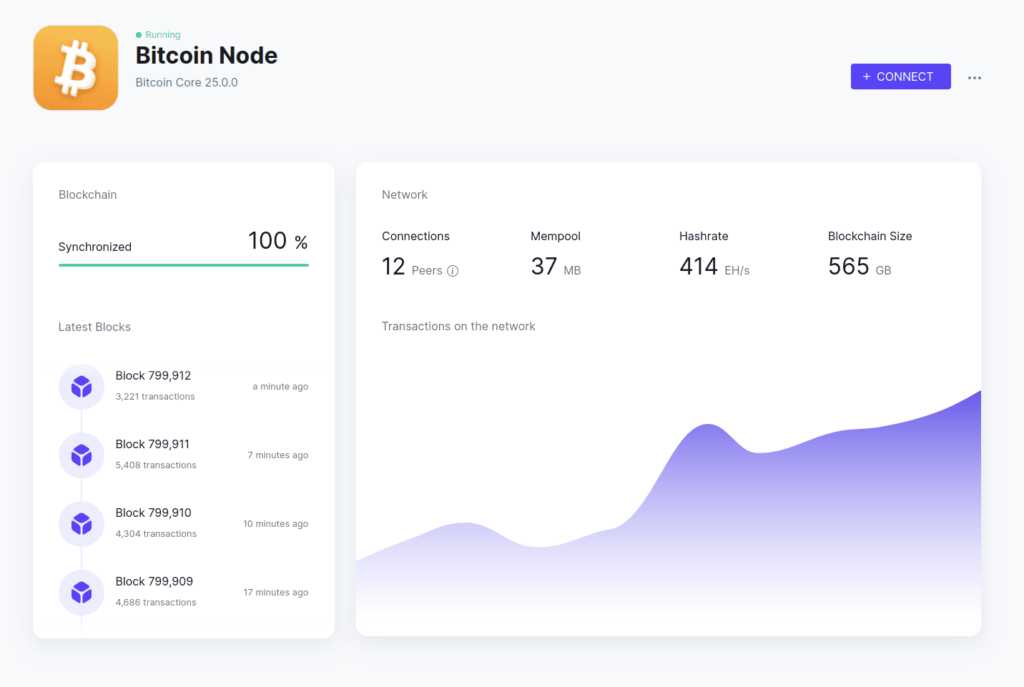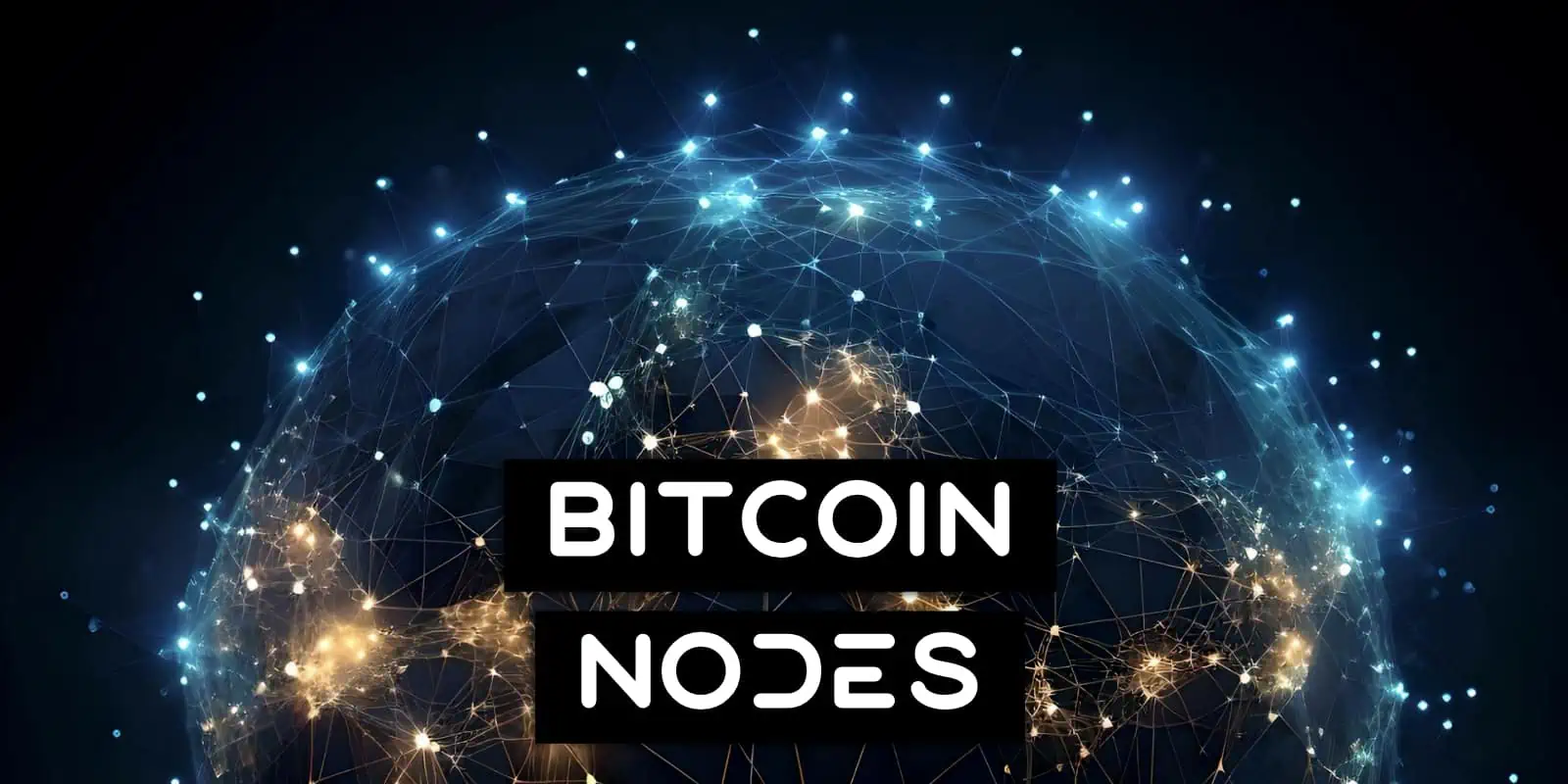Running a Full Bitcoin Node is one of the best things you can do for your privacy and security. It strengthens the network, enables you to receive payments if you run a business and a number of other ground breaking abilities like routing other peoples Lightning payments.
While many shy away from becoming a Node Runner because they think it’s too technical or expensive this is completely wrong. Running your own full node can be free and as easy as downloading an app. Just don’t don’t use a hard drive!
Contents
What Is A Bitcoin Node?
A Bitcoin Node is a computer that runs the Bitcoin Core software. This software is most commonly run as a Bitcoin Full Node which means it fully validates blocks and transactions. It also helps the Bitcoin network by receiving blocks from other full nodes, validating those blocks and the transactions inside them, and then forwarding the blocks onto other full nodes that it’s connected to.
The other main function a Full Bitcoin Node does is to serve lightweight clients such as wallet software. The Bitcoin Wallet will connect to the full node and broadcast its transaction to it. From there, the full node will validate the transaction and if it meets the rules of the Bitcoin Network, forward it onto its peers. This setup can be called a full node wallet and gives the user greatly improved privacy and security.
Why Run A Bitcoin Node?
There are a number of benefits to why you should Run A Bitcoin Node including:
- Increased Privacy: When you connect to a node it knows all your balances and transactions. By running your own node, this private information will not be shared with third parties
- Increased Security: When someone sends you bitcoins your full node will verify the transaction as well as the entire Bitcoin network ensuring that you’re not being fed false information or being sent fraudulent bitcoins
- To Strengthen Bitcoin: With every added full node, the decentralization and resilience of the network is increased. Your node runs your code and with that choice of code, you vote for how Bitcoin should be run. If a change to Bitcoin Core occurs and you disagree with it, you can choose not to update, voting with your node and helping to strengthen it against attacks
- To Help Others: Running your own node allows you to have other light clients (wallets) connect to it and benefit from the security and privacy benefits listed above. If you have family or friends that can’t run their own node, you can help them by letting them connect to yours
- To Learn: While running a node doesn’t require much effort, you can also dive deep into the many options and data that it has in order to learn more about how the Bitcoin Network itself operates
On top of all this there’s even more benefits such as being able to run your own private Bitcoin Mempool explorer (which further increases privacy) as well as run full self sovereign payment processing software such as BTCPay Server.
With this free software you can receive payments from any Bitcoin or Lightning Wallet directly to your full node without any third parties like a bank or Visa. If you’re a business this means that you no longer have to wait days or weeks for your funds to clear, pay ridiculous fees to banks and ensure that you and your customers information is kept private.
Can Bitcoin Nodes Make Money?

No, but actually yes. Let us explain.
Running a Bitcoin Node won’t bring you any profit, however running a Lightning Node can. We’ve gone into the details on Lightning Node Profitability already, so we won’t discuss it too much, but you can make money by routing other peoples payments on the Lightning Network. In order to run a Lightning Node you need to also have a Bitcoin Node for it to connect to.
As mentioned, full nodes can also be used by businesses to make and receive payments by their customers. This won’t make you money. but will save you a great deal in transaction fees.
How To Run A Bitcoin Node
Learning how to run a node doesn’t have to be expensive or hard. A core tenant of Bitcoin is to ensure nodes can be run by as many people as possible for as cheaply as possible to increase network decentralization as much as possible.
Cheaper and easier nodes means more nodes are run which means Bitcoin as a network becomes stronger and more diverse. This is also a core reason why Bitcoiners have long refused to increase block size. To do so would increase node storage costs and reduce decentralization and security.
How Much Does A Bitcoin Node Cost?
Bitcoin Nodes have two costs, their upfront hardware cost, covered below, and the ongoing costs due to power and Internet. Full nodes are usually run on desktop class hardware such as an old laptop / mini desktop PC or on low power hardware such as a Raspberry Pi.
A laptop or desktop computer might use 15-30 kWh per month while a Raspberry Pi’s will only use around 5-7 kWh per month. On top of this, expect your node to use roughly 20-50 GB of download and 30-200 GB of upload data per month. It’s recommended to have a broadband connection with no data cap.
If your power costs for example $0.10 / kWh and you already pay for Internet, a reasonable estimate might mean a full node could cost you $0.50 – $2 per month for power costs plus whatever you pay for the hardware costs up front.
New to Athena Alpha? Start today!
How To Set Up A Bitcoin Node
There’s dozens of ways to create a Bitcoin node as the Bitcoin Core software can run on virtually any hardware. What hardware you choose and what the best bitcoin node is will depend on what you want to use it for and how much you’d like to spend. Setting up a bitcoin node can be a fun project for both adults and kids and in general there’s three tiers:
- Free: Grab any laptop or computer you have that already has an OS installed on it. It can be new or old, it doesn’t matter. It can even be the same computer you use to run your wallet software. Download the official Bitcoin Core software (triple check it’s from https://www.bitcoin.org not any other domain) and install it. After it’s installed you’ll need to do some minor configuration and connect it to your wallet. We go through exact steps in our guide: How To Connect Sparrow Wallet To Bitcoin Core
- Medium Cost: If you want a node that is always on and fully dedicated to the Bitcoin Core software, then you can use an existing Raspberry Pi 4 8 GB or purchase one along with a 1+ TB SSD and connect them all together. We have a full build guide on how to build a sexy looking Umbrel Node for exactly this. This makes it easier as your node is “always online” and you can connect back to it with your phone or other wallets. You can also use or buy an old laptop too. From there, you can load on any number of Free and Open Source Software (FOSS) that serve as the main operating system such as Umbrel or myNode. You can also install Window or Linux on it and follow the Free steps above
- Higher Cost: If you want to run a serious Lightning Node with dozens of channels or just prefer really top tier hardware, you can buy custom built Bitcoin Nodes such as the Umbrel Home or Start9 Server Pure. You can also buy a more powerful and premium computer such as a Mini PC with a desktop class CPU or custom build your own one and again install Window or Linux on it and follow the Free steps above
Step by step instructions on how to fully build and configure a node (as well as how to run a bitcoin lightning node) is beyond the scope of this piece, but we do have a full guide on How To Build A Sexy Umbrel Node For $300.
Initial Block Download (IBD)

Once you’ve bought your hardware and installed Bitcoin Core your new node will need to go through a one time Initial Block Download or IBD process. This is where your node downloads the entire Bitcoin Blockchain, one block at a time, and validates each and every transaction right back to the very first Genesis Block back in 2009. The Bitcoin Blockchain is currently about 565 GB.
As you can imagine, this takes quite a bit of storage space, bandwidth, processing power and time. The faster your Internet connection, CPU and storage is, the faster this process will be. A Raspberry Pi 4 8 GB with a SSD and a 100 Mbps Internet connection should complete it in around 2-3 days. An old laptop or desktop with a SSD should do it in less than a day or so.
Bitcoin Node Requirements
Bitcoin.org officially states that the minimum requirements to run a Bitcoin Node is:
- Operating System: Windows / Mac / Linux
- CPU: Basically anything from a Raspberry Pi to Core i7
- RAM: 2 GB+
- Disk Space: 7 GB+
- Internet Connection: 0.4 Mbps+ Broadband
- Download Quota: 20 GB+ per month
- Upload Quota: 200 GB+ per month
However to get a good experience the most important thing is ensuring you use a SSD (either 2.5″ or M.2) that’s 1 TB or more and to also have sufficient RAM, preferably 8 GB or more.
The IBD requires a huge number of read/writes to the storage. If you’re using a mechanical HDD you’re gonna have a bad time trust us! We’re talking weeks of waiting! Use an SSD and it’ll be done in a day or three instead.
Regarding disk space, the 7 GB figure is for nodes that run in “Pruned Mode” and isn’t really the best experience as you miss out on a lot of the security and privacy benefits. The entire blockchain is 565 GB and growing at around ~50 GB per year. Thus a 1 TB drive should last for ~6 years or so, which isn’t terrible. If you’d like to truly future proof your node a 2 TB drive will give you enough storage space for a good 20+ years of operation.
Bitcoin Node Vs Miner
Bitcoin Nodes used to be the same as Bitcoin Miners in the early days of Bitcoin and you could mine bitcoins on a laptop CPU. As time went on and the hash rate of the network increased, it took more and more processing power to have any reasonable chance of creating a valid block.
Eventually even the most powerful CPU wasn’t enough and mining moved to GPUs and then to ASICs. These are custom built chips that perform the SHA 256 hashing algorithm incredibly efficiently. It’s these ASICs that are what we today call Bitcoin miners. At their heart, they still run a version of Bitcoin Core, however they don’t have full copies of the Blockchain on them.
Bitcoin Core originally had the software built in to mine bitcoin, however this was removed in 2016 when it became clear that ASIC miners had made CPU based mining obsolete. As such, in order to mine bitcoin now you need to use special hardware and join a mining pool using their software not Bitcoin Core.
Other nodes types include:
- Light Nodes: These only store block headers instead of full blocks. This allows them to interact with the Bitcoin Network and not have to download and store the entire Bitcoin Blockchain, but at the same time means they can’t fully validate the entire network. They use the least amount of disk space
- Pruned Nodes: These do store full blocks, but not the entire Bitcoin Blockchain. When you configure block pruning you specify a number and this limits the size of the stored blockchain file. This can be useful if you don’t have enough disk space and can be as little as 13 GB
- Archive Nodes: Full Archival Nodes are the same thing as a Full Node, they store a complete copy of the Bitcoin Blockchain, they’re just called a different name sometimes
- Lightning Nodes: These can connect to and interact with the Bitcoin Lightning Network which is separate to the Bitcoin Network. These nodes connect to and run along side a Full Bitcoin Node and require additional software on top of Bitcoin Core
- Mining Pool Nodes: These nodes operate to help organize and run Mining Pools. This is where a group of individual miners will pool their resources together in order to create new blocks. The mining pool node will distribute the block reward to each miner relative the amount of hashing power they’re contributing to the the pool
FAQ
How Many Bitcoin Nodes Are There?
How many nodes are there in the Bitcoin Network? About 50,000 or so. This figure obviously changes daily, but for a fantastic break down of how many global Full Bitcoin Nodes there are plus locations check out Bitnodes.
How Much Does It Cost To Run A Bitcoin Node?
Costs for running a node are mostly due to power and Internet costs. A desktop computer might use 20-30 kWh per month while a Raspberry Pi’s will only use around 7 kWh per month meaning at $0.10 / kWh total costs will be between $0.50 – $2 per month assuming you already have broadband Internet
How Much Is One Bitcoin Node?
A Bitcoin Node can cost anywhere from $0 up to $500-$1,000 depending on what computer hardware you run it on. You can run it on computers that are 5-10 year old for free or you can buy specially built node hardware for it, the choice is yours!
Is Running A Bitcoin Node Safe?
Yes. In fact, running your own Full Bitcoin Node enables a greater level of privacy and security than using a third parties node. This is because if you use another persons node, they can see all your transactions and entire wallet balance. The Bitcoin Core software is also likely the most reviewed and hardened code ever made.
Do Nodes Mine Crypto?
No… and yes. Bitcoin Nodes that run the Bitcoin Core software are technically capable of Bitcoin Mining as this function has been built into it from the beginning. However, as all mining has moved to ASICs, it’s no longer feasible to mine on a node.



